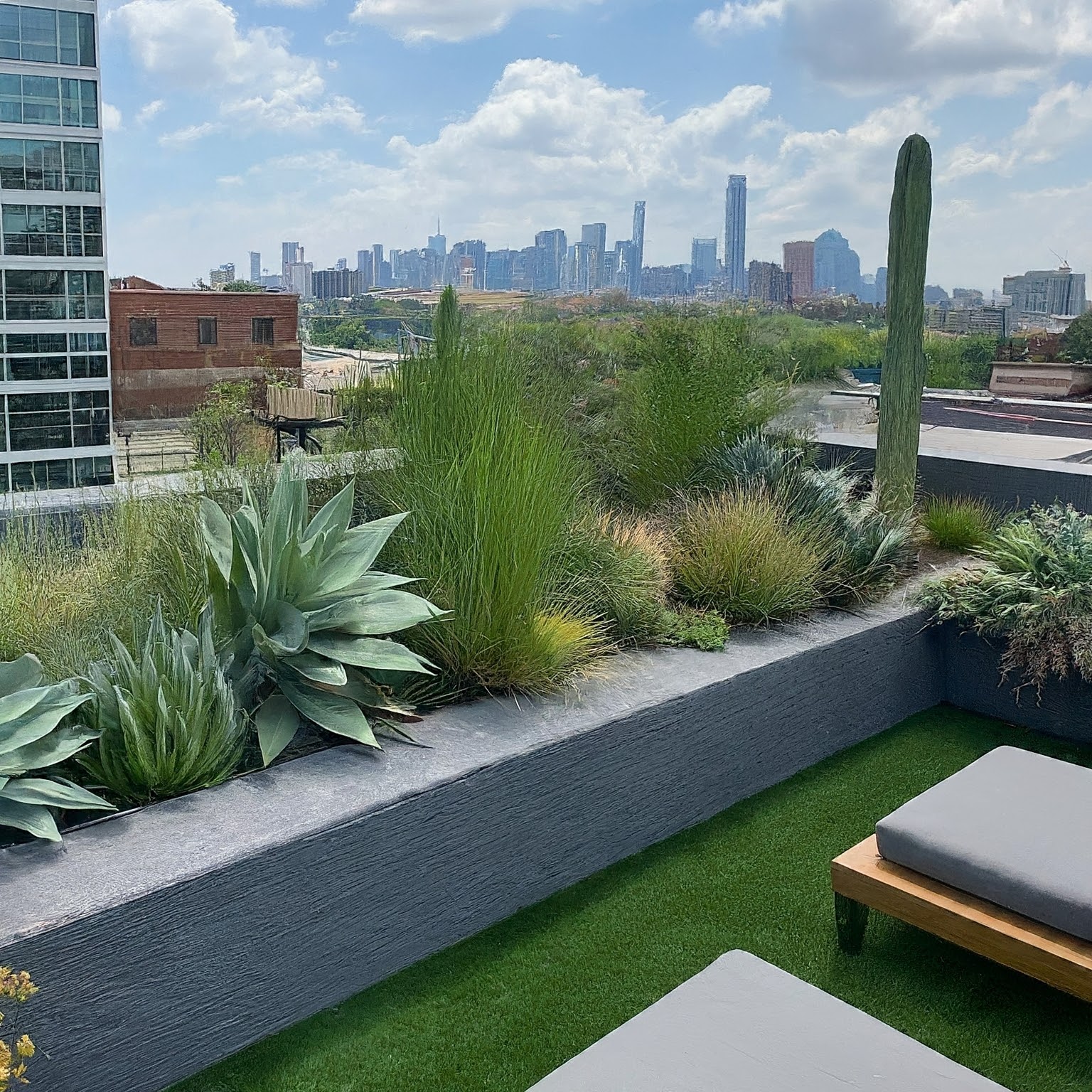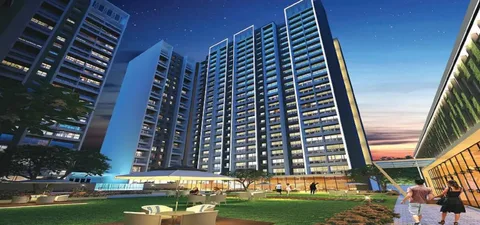Real Estate
Beyond Grey: Unleash the Hidden Urban Garden

Introduction
Greetings! I’m Amelia, a landscape architect with a passion for transforming concrete jungles into vibrant oases. Today, we’ll delve into the exciting world of urban gardens, exploring how even the most limited spaces can blossom into pockets of nature. This article caters to both design professionals and city dwellers alike, offering an inspiring perspective on incorporating green spaces into the urban landscape.
Why Urban Gardens Matter:
Imagine stepping out of your office building and into a calming sanctuary filled with the fragrance of herbs and the gentle hum of bees. This isn’t a utopian fantasy; it’s the very real potential of urban gardens. These pockets of green amidst the urban sprawl offer a multitude of benefits that extend far beyond aesthetics.
- Benefits for wellbeing: A study by the University of Washington [1] found that exposure to urban green spaces can significantly reduce stress levels, improve mood, and even boost cognitive function. Just a few minutes spent surrounded by nature can work wonders for our mental and physical health.
- Environmental benefits: Urban gardens act as the lungs of the city, filtering pollutants from the air and producing fresh oxygen. They also help manage rainwater runoff, reducing the strain on storm drain systems. In some cases, urban gardens can even contribute to local food production, promoting a more sustainable food system.
- Community building: Urban gardens foster a sense of community and belonging. People of all ages and backgrounds can come together to plant, care for, and harvest the fruits (and vegetables!) of their labor. These shared spaces encourage social interaction and create a stronger sense of place within the urban environment.

Picture by: Google Gemini
Unleashing Creativity: Design Ideas for Every Space:
The beauty of urban gardens lies in their adaptability. Whether you have a sprawling rooftop or a tiny balcony, there’s a green solution waiting to be explored. Here are some creative design ideas to spark your imagination:
-
Vertical gardens: These space-saving wonders transform walls, fences, or even balconies into lush vertical landscapes. There are several types of vertical gardens to choose from, each with its own advantages and considerations:
-
Green roofs: Not just for office buildings anymore! Green roofs offer a multitude of benefits, including insulation that reduces energy costs, stormwater management that lessens the burden on drainage systems, and even habitat creation for pollinators. While some green roof systems require professional expertise for complex structures, even small balconies or rooftops can be transformed into mini green havens with lightweight green roof trays and drought-tolerant plants.
-
Pocket parks: Those underutilized corners or traffic medians waiting to be revitalized? They hold the potential to become vibrant pocket parks. With careful planning and creative design, even the smallest spaces can be transformed into delightful green oases, offering a touch of nature and a welcome respite for city dwellers.
-
Upcycled containers: Embrace resourcefulness and sustainability by giving old objects a new lease on life. Repurpose bathtubs, tires, or even shoes into quirky planters. Upcycled containers add a unique touch to your urban garden while reducing waste.

Picture by: Google Gemini
Transforming Your Urban Space: A Step-by-Step Guide:
Ready to create your own urban oasis? Here’s a step-by-step guide to get you started:
-
Assess your space: Before diving headfirst into planting, take some time to evaluate your designated area. Consider factors like sunlight availability, water access, and the amount of space you have to work with. Knowing these limitations will help you choose the right plants and design a functional layout.
-
Choose suitable plants: Not all plants are created equal, especially in the urban environment. Opt for varieties that thrive in full or partial sun, depending on your space. Consider factors like pollution tolerance and maintenance needs. Herbs, succulents, and certain flowering plants are excellent choices for urban gardens.
-
Get resourceful: Creating an urban garden doesn’t have to break the bank. Get creative and resourceful! Utilize recycled materials like pallets or old crates to build raised beds. You can even create your own compost using kitchen scraps and yard waste, providing your plants with a nutrient-rich boost. Local gardening communities and online resources offer a wealth of information on cost-effective gardening solutions.
- Planting and Care: Once you have your chosen plants, pots, and soil, it’s time to get your hands dirty (in the best way possible)! Carefully follow planting instructions for each variety, ensuring proper spacing and depth. Regularly water your plants, paying close attention to their specific needs. Research common pests and diseases that might affect your urban garden, and implement organic solutions whenever possible.
Beyond Design: Resources and Inspiration:
The journey of your urban garden doesn’t end with planting. Here are some additional resources to help you flourish:
-
Local gardening communities: Connect with fellow urban gardeners through online forums or community gardens. These communities offer a wealth of knowledge, support, and inspiration. You can learn from experienced gardeners, share tips and tricks, and even participate in plant swaps or seed exchanges.
-
Urban gardening workshops: Many cities and organizations offer workshops on various aspects of urban gardening. These workshops are a fantastic opportunity to learn practical skills, such as seed starting, composting, or vertical garden construction. You’ll also gain valuable design inspiration and discover new plant varieties suitable for your urban environment.
Conclusion
By embracing urban gardens, we can transform our cities into vibrant ecosystems brimming with life. Imagine a cityscape dotted with verdant rooftops, cascading vertical gardens adorning buildings, and bustling community gardens bursting with color and activity. This isn’t just a dream; it’s a very real possibility.
Whether you’re an architect designing a sustainable masterpiece or a city dweller yearning for a touch of nature, unleash your creativity and explore the possibilities. Remember, every green space, big or small, contributes to a healthier, more beautiful urban environment. So, let’s get planting! Together, we can transform the grey into a flourishing green, one urban garden at a time.
Development
Modern Living: Daily Life at Max Delhi One in Sector 16B Noida

Delhi One project in Sector 16B Noida often comes up when you think about how daily life changes inside a mixed-use development. The idea of living where homes, offices, retail, and social spaces share one address feels modern, although questions about privacy, noise, and movement also surface.
A normal day at Max Delhi One gives a clearer picture of what this balance could look like once the development reaches completion. The project remains under development at present and stays open only for pre-booking, so the experience described here reflects the planned vision rather than a finished, lived-in reality.

A day at a glance inside Max Delhi One
- Morning routines that begin close to green pockets and internal walkways
- Office spaces and work hubs located within the same campus
- Retail and café zones supporting daily convenience
- Shared movement areas handling residents, visitors, and professionals
- Clear zoning that the builder plans carefully to separate uses
Each of these elements shapes how daily life might feel at Max Estates Delhi One in Sector-16B, Noida, especially for buyers evaluating long-term comfort rather than short-term excitement.
Mornings shaped by proximity and planning
A typical morning inside Delhi One could feel calmer than expected. Residential towers are planned to sit slightly away from high-footfall commercial edges, so early hours remain relatively peaceful. Natural light reaches homes easily, and walking paths allow residents to step outside safely and smoothly without leaving the campus.
Workdays often begin without long commutes, even though offices operate within the same development. Many residents may simply walk down or across landscaped zones to reach professional spaces, and this proximity saves time significantly. In contrast to standalone residential societies, the mixed-use format creates movement earlier in the day, although traffic stays internal and structured.
Most importantly, mornings inside Max Delhi One Sector 16B Noida could feel efficient rather than rushed, as daily essentials remain close by.
Work, errands, and midday movement
Midday hours reveal the true nature of a mixed-use environment. Office workers, visitors, and residents share the campus, although zoning keeps flows organized thoughtfully. Retail areas attract footfall during lunch hours, and cafés or service outlets serve both professionals and residents.
This shared energy supports convenience, even though privacy sometimes feels reduced in common areas. In fact, compared to purely residential projects, internal circulation remains more active during business hours. The builder plans circulation routes carefully, so residential entries stay distinct from office lobbies, which helps maintain order.
As a result, daily errands become easier, although awareness of peak movement hours becomes important for residents who value quieter surroundings.
Evenings that blend activity and retreat
Evenings inside Max Towers at Delhi One could offer a balance between vibrancy and retreat. Retail zones remain active for longer hours, which adds life to the campus and improves safety through continuous presence. Families may use landscaped areas while others head to cafés or meet friends nearby.
On the other hand, residents sensitive to crowd movement may notice increased activity closer to commercial edges. Residential towers positioned inward generally experience calmer surroundings. This contrast highlights how unit selection plays a major role in comfort.
Surprisingly, mixed-use environments often feel safer at night due to managed footfall and lighting, although complete silence remains rare.
Trade-offs you should realistically expect
Daily life at Max Delhi One offers several advantages, although compromises remain part of the experience.
Benefits
- Time savings due to work and daily needs staying nearby
- Active surroundings that feel lively and secure
- Higher long-term relevance due to integrated planning
Trade-offs
- Reduced privacy in shared zones during peak hours
- Internal traffic that requires adjustment
- Noise levels that vary by tower placement
You are probably looking for confirmation, not persuasion. This balance matters when evaluating whether mixed-use living suits your lifestyle.
How to choose a quieter unit inside Delhi One
Unit selection plays a decisive role in shaping daily comfort. A few practical considerations help buyers align expectations smartly:
- Residential towers located deeper inside the campus usually experience less retail noise.
- Higher floors often feel calmer, as ground-level activity stays below.
- Units facing landscaped greens rather than commercial blocks offer better acoustic comfort.
- Entry points away from office lobbies reduce shared movement.
- Future construction phases should remain visible on the master plan to avoid surprises.
We as realtors guide buyers carefully through layout drawings and zoning maps, since mixed-use projects demand closer attention to micro-planning.
Living with a long-term perspective
Life inside Max Delhi One should be seen through a long-term lens. The project stays under development and remains open only for pre-booking, so timelines and execution quality matter significantly. Max Estates approaches planning professionally, although final experiences depend on delivery consistency.
In addition, mixed-use developments often age better when managed well, as residential demand stays supported by nearby commercial activity. Consequently, daily convenience aligns with value retention over time.
Conclusion: what daily life could truly feel like
Daily life at Delhi One appears practical, active, and structured, even though absolute quiet remains unlikely. The environment suits people who value proximity, time efficiency, and urban convenience, while understanding shared spaces come with shared movement. Careful unit selection helps reduce trade-offs significantly.
Verification always matters more than assumptions. We recommend reviewing approved plans, zoning layouts, and amenity positioning directly before making decisions. Detailed project information, development updates, and official specifications remain available on the official website.
Development
Flats in Thane Are Mumbai’s Most Sought-After Residential Choice
Real Estate
Professional Tactics to Scale Vacation Rental Revenue

Introduction
In today’s competitive hospitality market, growing a Vacation Rental Business requires more than just listing properties online. Property owners and managers need smart strategies to maximize occupancy, increase revenue, and deliver exceptional experiences. Scaling revenue is not only about pricing but also about understanding guest behavior, marketing effectively, and streamlining operations.
Understand Your Target Guests
One of the most important steps to growing your vacation rental revenue is understanding the type of guests you want to attract. When you know who your guests are, you can design your property, write better listings, and set prices that match their expectations.
Your guests may include families, couples, business travelers, remote workers, solo travelers, or large groups. Each group has different needs. Families may want a safe property with extra beds, while remote workers look for strong Wi-Fi and a quiet space. When your rental meets their needs, guests feel more comfortable and are more likely to book, return, and leave positive reviews.
Optimize Your Pricing Strategy
A successful pricing strategy is the foundation of high vacation rental revenue. Fixed prices rarely work because demand changes throughout the year. Instead, you should adjust your rates based on seasons, weekends, holidays, local events, and last-minute gaps.
Here are key pricing tactics:
- Use dynamic pricing tools to adjust rates automatically.
- Increase prices during holidays, festivals, and local events.
- Offer discounts for extended stays to attract long-term guests.
- Add small fees for extra services like early check-in or late check-out.
- Check competitor pricing to stay competitive without undercharging.
Smart pricing helps you earn more from each booking while keeping your property attractive to guests.
Optimize Your Pricing Strategy
Pricing is the cornerstone of any profitable vacation rental. Smart pricing can significantly increase occupancy while maximizing revenue. Understanding demand patterns, seasonality, and local events is essential to get your rates just right.
1. Use Dynamic Pricing Tools
Dynamic pricing software adjusts rental rates based on demand, competition, and seasonal trends. These tools help property owners stay competitive while optimizing income without manual guesswork.
2. Analyze Competitor Rates
Regularly monitoring similar properties in your area allows you to set competitive rates. Pricing too high can lead to vacancies, while too low undervalues your property. Balance is key.
3. Offer Flexible Stay Options
Offering weekly or monthly discounts can attract longer-term guests. Flexible minimum-night stays appeal to a broader audience and can increase occupancy during slower periods.
Enhance Guest Communication
Effective Guest Communication is more than answering inquiries. It’s about creating memorable experiences that encourage repeat bookings and positive reviews. A streamlined communication strategy ensures guests feel valued and informed throughout their stay.
1. Automate Messaging for Efficiency
Automated messaging tools allow you to send check-in instructions, reminders, and thank-you notes without manually responding every time. This maintains professionalism and improves guest satisfaction.
2. Personalize Guest Interactions
Personal touches, such as addressing guests by name or offering local recommendations, build rapport. Personalized communication increases the likelihood of positive reviews and repeat visits.
3. Respond Promptly to Inquiries
Timely responses to booking requests and questions can make or break a guest’s decision. Fast communication signals reliability and encourages bookings over competitors who are slow to reply.
Invest in Property Presentation
The way your property is presented online heavily influences booking decisions. High-quality visuals, detailed descriptions, and appealing amenities can significantly boost revenue.
1. Professional Photography Matters
Invest in professional photos showcasing the best features of your property. Bright, clear images highlight space, cleanliness, and ambiance, encouraging more bookings.
2. Optimize Listings for Search Engines
Include relevant keywords, property details, and amenities in your listing. SEO-friendly descriptions help your property appear in more searches and attract potential guests actively looking to book.
3. Highlight Unique Amenities
Showcasing unique offerings, like a hot tub, pool, or pet-friendly accommodations, differentiates your property. Highlight these features in your listing to justify higher rates and attract niche travelers.
Invest in Property Presentation
The way your property is presented online heavily influences booking decisions. High-quality visuals, detailed descriptions, and appealing amenities can significantly boost revenue.
1. Professional Photography Matters
Invest in professional photos showcasing the best features of your property. Bright, clear images highlight space, cleanliness, and ambiance, encouraging more bookings.
2. Optimize Listings for Search Engines
Include relevant keywords, property details, and amenities in your listing. SEO-friendly descriptions help your property appear in more searches and attract potential guests actively looking to book.
3. Highlight Unique Amenities
Showcasing unique offerings, like a hot tub, pool, or pet-friendly accommodations, differentiates your property. Highlight these features in your listing to justify higher rates and attract niche travelers.
Invest in Property Presentation
The way your property is presented online heavily influences booking decisions. High-quality visuals, detailed descriptions, and appealing amenities can significantly boost revenue.
1. Professional Photography Matters
Invest in professional photos showcasing the best features of your property. Bright, clear images highlight space, cleanliness, and ambiance, encouraging more bookings.
2. Optimize Listings for Search Engines
Include relevant keywords, property details, and amenities in your listing. SEO-friendly descriptions help your property appear in more searches and attract potential guests actively looking to book.
3. Highlight Unique Amenities
Showcasing unique offerings, like a hot tub, pool, or pet-friendly accommodations, differentiates your property. Highlight these features in your listing to justify higher rates and attract niche travelers.
Conclusion
Scaling a vacation rental business requires a combination of strategic pricing, effective guest communication, and polished property presentation. By investing in these areas, property owners can increase revenue, attract more bookings, and build a reputation for exceptional stays. Consistency, personalization, and optimization are the keys to long-term success in this competitive market.
FAQs
Q1: How can I increase occupancy in my vacation rental?
A: Focus on dynamic pricing, seasonal promotions, and flexible stay options. Optimizing your online listing and improving guest communication also encourages bookings.
Q2: What is the best way to handle guest complaints?
A: Address complaints promptly and professionally. Listen actively, offer solutions, and ensure the guest feels valued. Positive resolutions can turn negative experiences into positive reviews.
Q3: Should I manage my vacation rental myself or hire a manager?
A: If you have multiple properties or limited time, hiring a property manager can save effort and improve guest satisfaction. Otherwise, managing it yourself allows for more control and personalization.
-
Business2 years ago
Cybersecurity Consulting Company SequelNet Provides Critical IT Support Services to Medical Billing Firm, Medical Optimum
-
Business2 years ago
Team Communication Software Transforms Operations at Finance Innovate
-
Business3 years ago
Project Management Tool Transforms Long Island Business
-
Business2 years ago
How Alleviate Poverty Utilized IPPBX’s All-in-One Solution to Transform Lives in New York City
-
health3 years ago
Breast Cancer: The Imperative Role of Mammograms in Screening and Early Detection
-
Sports3 years ago
Unstoppable Collaboration: D.C.’s Citi Open and Silicon Valley Classic Unite to Propel Women’s Tennis to New Heights
-
Art /Entertainment3 years ago
Embracing Renewal: Sizdabedar Celebrations Unite Iranians in New York’s Eisenhower Park
-
Finance3 years ago
The Benefits of Starting a Side Hustle for Financial Freedom
































